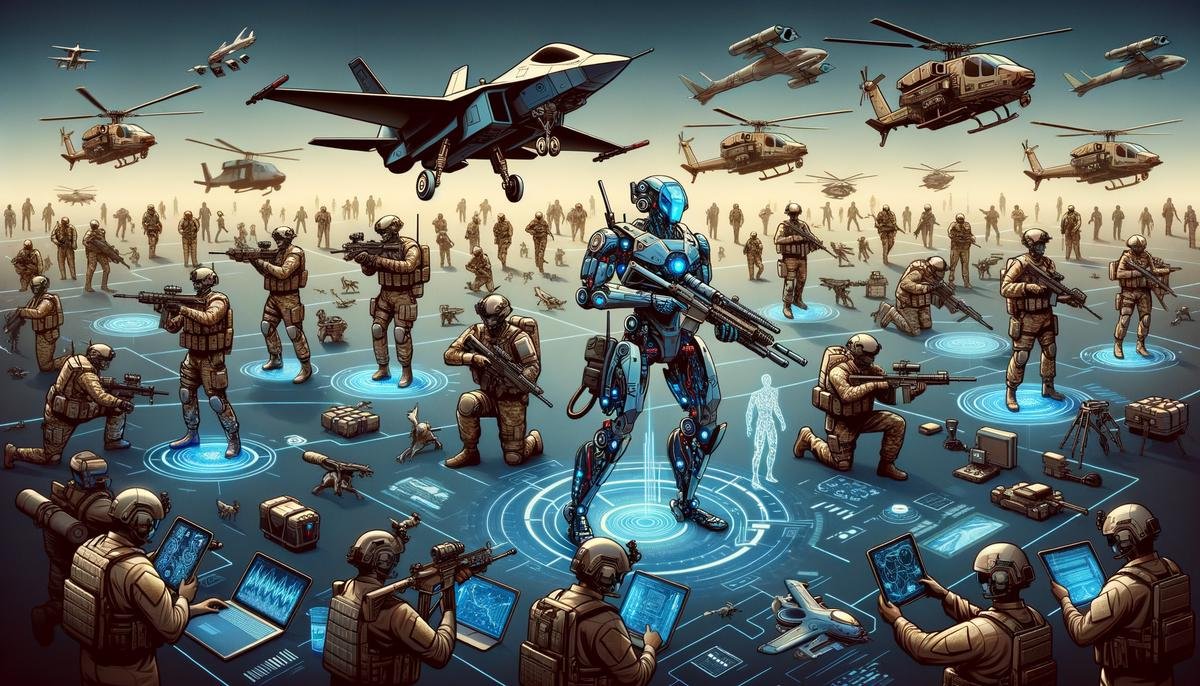Human-Machine Decision Making
AI systems are increasingly used in military operations, combining human judgment with artificial intelligence. These systems can detect targets, predict enemy movements, and suggest strategies with superhuman capabilities. However, they rely on data, algorithms, and decisions made by their developers.
Human oversight remains critical. Justin Biddle, director of Georgia Tech’s ETHICx, emphasizes that AI systems reflect the values of their creators. Humans must stay in the decision loop, especially when lives are at stake. For instance, if an AI misidentifies a target, a human operator must decide quickly under pressure.
The concept of responsibility in AI-assisted warfare is complex. In traditional operations, commanders bear full responsibility for outcomes. AI blurs these lines, raising questions about accountability if an AI system malfunctions. The U.S. Department of Defense insists on human control, but ensuring this becomes challenging as AI tools become more integrated.
The “kill chain” or “kill web” in military operations represents an intricate network where human and machine decisions intertwine. For example, Rafael’s Fire Weaver system can detect enemies and suggest the best unit to engage, leaving the soldier with a binary choice:
- Approve the engagement
- Abort the mission
This raises concerns about whether humans are truly making decisions or merely executing machine recommendations.
Balancing AI’s efficiency with ethical responsibility remains a key challenge. Projects like DARPA’s Urban Reconnaissance through Supervised Autonomy (URSA) incorporate ethical considerations by limiting AI to identifying “persons of interest” rather than threats. As AI advances in military operations, maintaining human judgment and accountability will be crucial.
Autonomous Weapons Systems
Autonomous weapons systems can select and engage targets without direct human intervention, raising profound questions about warfare ethics and human oversight. Key concerns include:
- Loss of human accountability: When autonomous systems make mistakes, determining responsibility becomes complex.
- Risk of malfunction: Errors due to software bugs, environmental conditions, or adversarial interventions could have catastrophic consequences.
- Ethical implications: Machines lack the ability to empathize, reason morally, or understand complex humanitarian situations.
International regulations reflect these concerns. The UN Convention on Certain Conventional Weapons recommends limiting the duration, geographical scope, and scale of autonomous weapons operations. The European Union emphasizes accountability, transparency, and human oversight in autonomous systems deployment.
“The U.S. Department of Defense has outlined ethical principles for AI use, stressing responsible use and human judgment at critical points.”
The debate on autonomous weapons systems focuses on aligning technological progress with ethical and moral values while maintaining human accountability and addressing the moral implications of autonomous decision-making.

Bias and Discrimination in AI
AI systems in warfare can perpetuate biases present in their training data, potentially leading to discriminatory outcomes with life-and-death consequences. Historical datasets may reflect societal biases, which can be inadvertently reinforced by AI systems.
Biased AI in military applications can disproportionately impact marginalized groups. For instance, if an AI system for predicting enemy combatants is trained on data that over-represents certain ethnicities as threats, it could lead to wrongful targeting and increased casualties among those groups.
Justin Biddle of Georgia Tech’s ETHICx emphasizes the need for inclusive participation in AI development to mitigate these biases. Developers and policymakers have an ethical responsibility to strive for fairness and equity by:
- Diversifying datasets
- Rigorously testing systems for bias
- Incorporating fairness into AI algorithms
International regulations, such as the EU’s General Data Protection Regulation and the forthcoming AI Act, mandate transparency and accountability in automated decision-making. In the U.S., the AI Bill of Rights proposes guidelines for AI-driven decisions, though these lack enforcement mechanisms1.
Addressing bias in military AI requires a multifaceted approach combining technical precision with ethical oversight. Stakeholders must collaborate to ensure these technologies respect principles of justice, equity, and human dignity.
Legal and Ethical Accountability
Accountability in using AI for military operations presents challenges, requiring examination of legal frameworks and ethical principles. When AI systems cause unintended harm, responsibility involves developers, operators, and policymakers.
Legal frameworks lag behind AI advancements in warfare applications. The Geneva Conventions and United Nations Convention on Certain Conventional Weapons (CCW) protocols provide a basis for international humanitarian law, but their application to AI-related incidents is unclear.
Ethical guidelines, like the U.S. Department of Defense’s five ethical principles for AI, stress human judgment at critical points. The “Responsibility” principle asserts that human oversight is essential, ensuring that when problems occur, a human is held accountable. Yet, implementing this principle is challenging.
Accountability questions are complex when AI systems make autonomous decisions. For example, if an AI-powered drone misidentifies a civilian area as a military target and attacks, determining responsibility involves multiple decision-making layers. Military officials often argue that ultimate responsibility lies with commanders and policymakers, while ethicists contend that developers and engineers must also ensure the technology is safe and ethical.
Legal experts note that current laws often lack specificity to address AI accountability nuances. Rebecca Crootof, a law professor specializing in autonomous systems ethics, states that adding AI to the command chain diffuses responsibility across decision-making layers.
Military protocols have traditionally protected top-tier decision-makers from liability, a practice critiqued by legal scholars. Gregory Allen, director of the Wadhwani Center for AI and Advanced Technologies, suggests that AI systems’ complexity and classification make it hard to pinpoint failures and determine accountability.
Ethically, there’s an argument for shared responsibility across an AI system’s lifecycle. Courtney Bowman, global director of privacy and civil liberties engineering at Palantir, argues for a distributive accountability model that allocates responsibility across all relevant stakeholders.
Practical steps for AI accountability:
- Rigorous testing and validation of AI systems
- Ongoing monitoring during use
- Open channels for reporting concerns
- Regular audits by independent bodies
Adopting standards similar to those proposed in the European Union’s Artificial Intelligence Act may be vital for better governance.
Ensuring strong accountability frameworks will require international cooperation, transparent policies, and commitment to ethical principles across all AI development and deployment levels.
Future of AI in Warfare
The future of AI in warfare promises both advantages and ethical challenges. Emerging technologies, such as AI-driven kill webs and advanced autonomous systems, will transform the battlefield, requiring reevaluation of existing ethical and legal frameworks.
AI-driven kill webs form complex, interconnected networks of decision nodes where humans and AI collaborate. These webs use real-time data from numerous sensors and platforms, providing rapid situational awareness. While this integration can improve operational efficiency and precision, it also raises questions about delegating life-and-death decisions to machines.
In a kill web scenario, an AI system might identify multiple targets simultaneously, assigning priorities and recommending engagements almost instantly. The speed and complexity of these operations can overwhelm human operators, effectively reducing their role to validating or rejecting the AI’s recommendations.
AI systems may operate in ways humans might not fully understand or predict. Machine learning algorithms, particularly those using deep learning, can develop opaque decision-making processes. This “black box” nature of AI poses risks, as operators might struggle to discern why a system made a particular recommendation.
As AI systems become more sophisticated, they may exhibit emergent behaviors—unexpected actions arising from complex algorithms and real-world environment interactions. Such behaviors could have severe consequences in a military context.
Addressing Future Developments:
- Implement strong oversight mechanisms
- Conduct continuous monitoring and validation of AI systems
- Perform independent audits
- Ensure transparency in AI processes
- Maintain open channels for reporting concerns
International collaboration will be vital in establishing standardized regulations governing AI use in warfare. Global treaties and agreements could provide a framework for managing advanced military AI systems’ proliferation and use.
Military and civilian stakeholders must engage in ongoing dialogue to develop ethical guidelines that keep pace with technological advancements. Education and training for military personnel on the ethical use of AI are paramount.
The future of AI in warfare will require balancing technological advancements and maintaining ethical standards. Commitment to transparency, accountability, and international cooperation will be essential in ensuring that AI serves as a force for good rather than a catalyst for ethical erosion.

Conclusion
As AI continues to integrate into military operations, balancing technological advancement and ethical responsibility remains crucial. Maintaining human oversight and accountability ensures that justice and human dignity principles are upheld, even as innovation rapidly progresses.




